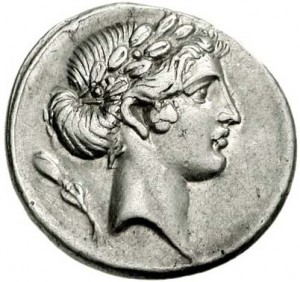Daphne’s Appeal to Gaia

Apollo is usually depicted with a crown of laurel leaves. Roman coin 56 b.c.e. Photo by Classical Numismatic Group.
A priestess of Gaea, this nymph led secret women’s rituals in celebration of the Earth’s femininity. But the mortal Leucippus tried to penetrate their rituals in female disguise. The all-seeing sun, who had ulterior motives for his action, suggested to the women that they conduct their rituals nude, to be certain that there were no male intruders.So the mortal was found and destroyed for his sacrilege. Then the sun-god’s motives became clear. He accosted the beautiful priestess and demanded that she sleep with him. She refused. Apollo grew violent. Chasing her, intent on rape, he overpowered Daphne. But she cried out to the goddess she served, Mother Earth, and instantly was transformed into a laurel tree. The repentant Apollo thereafter wore laurel wreaths in his hair and honored the tree as the symbol of inspiration.
From Robert Graves’ The Greek Myths:
Apollo was not invariably successful in love….he pursued Daphne, the mountain nymph, a priestess of Mother Earth, daughter of the river Peneius in Thessaly; but when he overtook her, she cried out to Mother Earth who, in the nick of time, spirited her away to Crete, where she became known as Pasiphae. Mother Earth left a laurel-tree in her place, and from its leaves Apollo made a wreath to console himself.
Graves usually relates the more violent myths to Greek political upheavals:
His pursuit of Daphne the Mountain-nymph, daughter of the river Penius, and priestess of Mother Earth, refers apparently to the Hellenic capture of Tempe, where the goddess Daphoene (“bloody one”) was worshiped by a college of orgiastic laurel-chewing Maenads. After suppressing the college — Plutarch’s account suggests that the priestesses fled to Crete, where the Moon-goddess was called Pasiphae. Apollo took over the laurel which, afterwards, only the Pythoness might chew. Daphoene will have been mare-headed at Tempe, as at Phigalia; Leucippus (“white horse”) was the sacred king of the local horse cult, annually torn in pieces by the wild women….
The Maenads were priestesses who practiced ecstatic rites, often involving drugs or alcohol.The story of Daphne and Apollo was popular amongst the Greeks and there are many variations. It is interesting, considering the cross-dressing angle of the story, that one of the priestess daughters of Terisias was named after Daphne. (Teresias was the soothsayer famous for transforming from man to woman back to man.) This was probably once a complex myth that we only have in truncated form.
The Daphne myth was a fairly common theme in Renaissance art. The lyrics of this song by John Dowland (1563-1625) speak of Apollo’s unrequited desire for Daphne.Rest awhile you cruel cares,be not more severe than love.Beauty kills and beauty spares,and sweet smiles sad sighs remove:Laura faire queen of my delight,Come grant me love in love’s despite,And if I ever fail to honour thee,Let this heavenly light I see,Be as dark as hell to me.If I speak, my words want weight,am I mute, my heart doth break.If I sigh, she fears deceit,sorrow then for me must speak:Cruel, unkind, with favour viewThe wound that first was made by you,And if my torments feigned be,Let this heavenly light I see,Be as dark as hell to me.Never hour of pleasing rest,Shall revive my dying ghost.Till my soul hath repossess’dThe sweet hope which love hath lost:Laura redeem the soul that dies,By fury of they murdering eyes:And if it prove unkind to thee,Let this heavenly light I see,Be as dark as hell to me.SourcesGraves, Robert. The Greek Myths. London: Penguin Books, 1960.Monaghan, Patricia. The Book of Goddesses and Heroines. St Paul, MN: Llewellyn, 1990.
